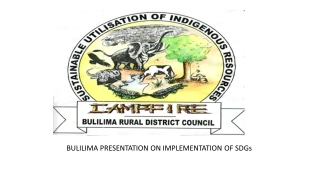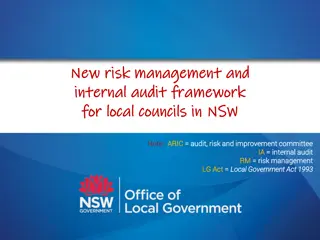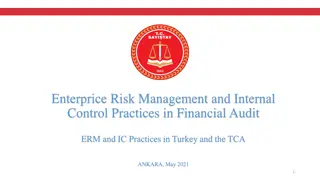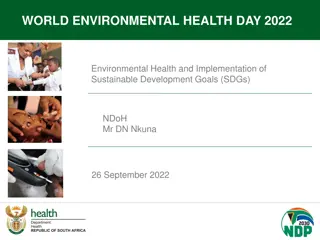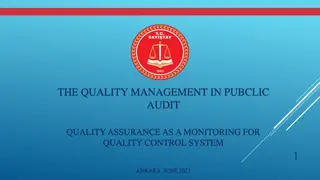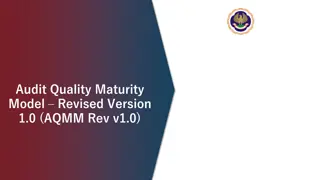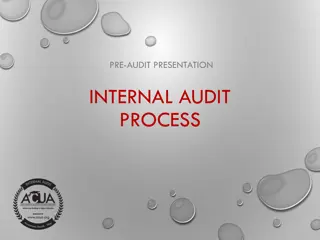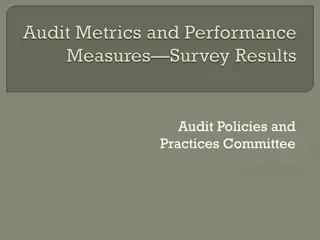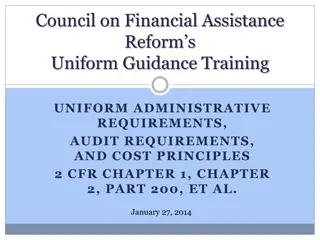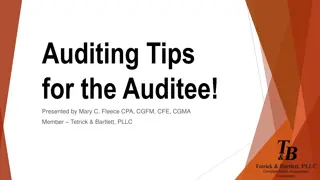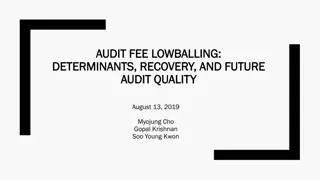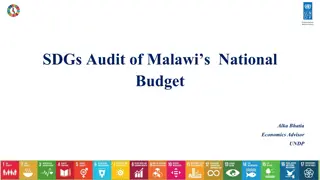Audit Practices for SDGs Implementation Evaluation in Turkey
This content delves into the process of auditing the implementation of Sustainable Development Goals (SDGs) in Turkey, focusing on renewable energy policies. It covers topics such as audit perspective, selecting audit topics, the link between national targets and SDGs, planning stages, defining audit scope, and the audit objective. The aim is to evaluate Turkey's efficiency in achieving targets related to increasing renewable energy sources, within the framework of SDGs principles.
Download Presentation

Please find below an Image/Link to download the presentation.
The content on the website is provided AS IS for your information and personal use only. It may not be sold, licensed, or shared on other websites without obtaining consent from the author. Download presentation by click this link. If you encounter any issues during the download, it is possible that the publisher has removed the file from their server.
E N D
Presentation Transcript
SDGs AUDIT PERSPECTIVE and PRACTICES of TCA AUDIT of IMPLEMENTATION of the SDGs
THE BASIS of AUDIT of IMPLEMENTATION of SDGs INTOSAI Strategic Plan 2017-2022 Moscow Declaration INCOSAI/2019 ISAM (IDI/SDGs Implementation Audit Model-March/2020)
SELECTING AUDIT TOPIC Mandate Significance Auditability Audit capacity Audit impact National priorities
RENEWABLE ENERGY Media coverage Economic Public interest Social Political Environmental
THE LINK BETWEEN THE NATIONAL TARGET AND THE SDG SDGs 7.2 Affordable and Clean Energy: By 2030, increase substantially the share of renewable energy in the global energy mix. Our national goal is: raising the total share of the electricity generation from the renewable energy sources up to the level of %38,8. (11th Development Plan of Turkey)
PLANNING STAGE Audit objective Scope of the audit Audit approach Audit questions Audit criteria Audit risk Methodology Audit matrix
AUDIT OBJECTIVE To evaluate the efficiency of Turkey's policy and practices regarding the selected national targets aimed at increasing the share of renewable energy sources in the total electricity generation of Turkey, within the framework of SDGs principles.
DEFINING AUDIT SCOPE ISSAI 5130 keep the scope of SDGs implementation audit as narrow as possible to make a deep evaluation of the government practices by taking into account not only the achievement of the national target but also the achievement of the SDGs considerations.
WHICH PERIOD WILL THE AUDIT COVER? For the starting point of the audit,the SAI auditor may - Look at trends, information, policy changes, etc., since the objectives were first articulated inthe national context (e.g. a policy on that subject was formulated, legislation enacted). -Select a specific year prior to the adoption of the 2030 Agenda as a basis for comparison The end point of the audit should be as close as possible to the finalisation of the audit.
ISAM and the SDG CONSIDERATIONS Multi stakeholder engagement, Inclusiveness (leaving no one behind), Policy coherence between vertical and horizontal levels of the government within the framework of the whole government approach
AUDIT APPROACH Program Base + Output Base We evaluate the efficiency of policy and practices as well as the achievement of the SDGs considerations We evaluate the achievement of the national target
AUDIT QUESTIONS Have the institutional arrangements been made within the framework of the horizontal-vertical policy alignment principle? Are adequate coordination and harmonization mechanisms foreseen among the actors?
AUDIT QUESTIONS Have the relevant stakeholders participated in the process of creating plans and programs? Regarding the selected target, have the planned goals been achieved?
SETTING AUDIT CRITERIA good practices of countries, international agreements, expert organizations and stakeholder reports, strategic documents of institutions, plans and programmes of the government. etc..
AUDIT RISK The audit methodology has not been clear and in final form yet The audit topic requires intense technical knowledge The subject has not been audited before by TCA.
AUDIT RISK The audit topic is quite sophisticated because it has inherently international political, economic and environmental dimensions Since the issue is related with many institutions and organizations particularly with private sector, access to reliable data may be difficult
METHODOLOGY Performance Audit Methodology (ISSAI 300/3000/3100) +ISAM The SDG implementation audit is a kind of performance audit which also includes essential aspects of fundamental principles of 2030 Agenda and SDGs. Auditors should track and evaluate to what extent the government success the SDGs considerations besides the achievement of the selected national target. Effective and appropriate techniques regarding collection of evidence and data analysis should be used.
INSTITUTIONS TO BE INTERVIEWED Ministry of Energy, Energy Market Regulatory Authority, General Directorate of State Hydraulic Works, Ministry of Environment, Association of Municipalities of Turkey, Municipalities, NGOs, Universities, Private sector and companies.
CONCLUDING REMARKS Each country's SAI should give particular importance to its national priorities in selecting the national target to be audited and even at every stage of the audit. There are some difficulties as it is a first-time type of audit. SDG implementation audit is a kind of performance audit which also includes essential aspects of fundamental principles of 2030 Agenda and SDGs. Both programme and output base audit approach
CONCLUDING REMARKS We should both evaluate the achievement of the national target and the fulfilment of the SDGs considerations: multi -stakeholder engagement, inclusiveness (leaving no one behind), coordination and integration between vertical and horizontal levels of the government within the framework of the whole of government approach.
CONCLUDING REMARKS We should keep the scope of the audit as narrow as possible. We should carefully determine the period that the audit will cover. We will also need other types of source of criteria this once. We should carefully define the audit risk and try to handle it during the whole audit process.
THANKS A LOT FOR YOUR LISTENING. THANKS A LOT FOR YOUR LISTENING . B RA L LEC TORUN/SDG AUDIT TEAM LEADER OF TCA


